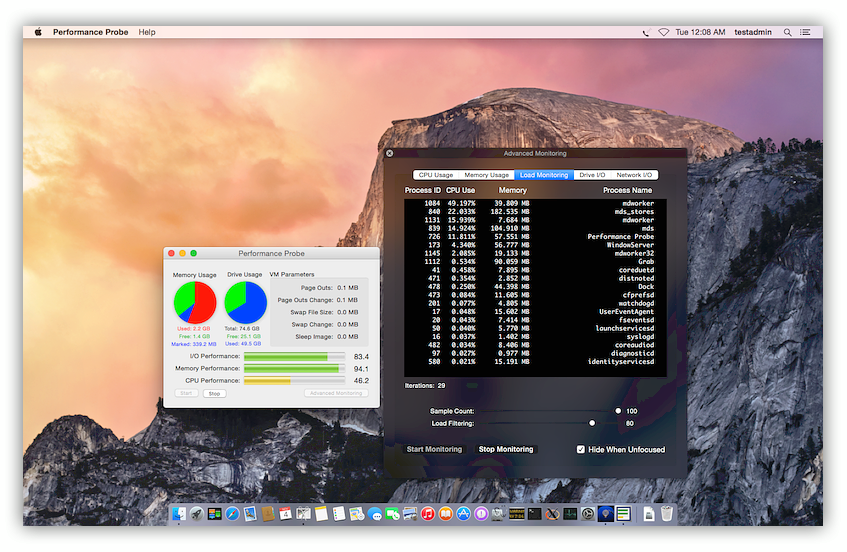
- #Performance probe serial number#
- #Performance probe manual#
- #Performance probe full#
- #Performance probe software#
- #Performance probe Offline#
The MX Security Appliance is a cloud managed networking device. Configuration of the upstream firewall may be required to allow this communication. The MX Security Appliance makes use of several types of outbound communication. In this configuration, the MXs will send their cloud controller communications via their uplink IPs, but other traffic will be sent and received by the shared virtual IP address. The virtual uplink IPs option uses an additional IP address that is shared by the HA MXs. In order to properly communicate in HA, VPN concentrator MXs must be set to use the virtual IP (VIP). Use Uplink IPs is selected by default for new network setups. Finally, select whether to use MX uplink IPs or virtual uplink IPs.
#Performance probe serial number#
Next, enter the serial number of the warm spare MX or select one from the drop-down menu. Begin by clicking "Configure w arm s pare" and then " Enabled". High availability (also known as a warm spare) can be configured from Security & SD-WAN > Monitor > Appliance status. For more detailed information about MX warm spare, please see here. The HA implementation is active/passive and will require the second MX also be connected and online for proper functionality. High availability on MX Security appliances requires a second MX of the same model. The VPN concentrator will reach out to the remote sites using this port, creating a stateful flow mapping in the upstream firewall that will also allow traffic initiated from the remote side through to the VPN concentrator without the need for a separate inbound firewall rule. If automatic NAT traversal is selected, the MX will automatically s elect a high numbered UDP port to source AutoVPN traffic from.
#Performance probe manual#
None of the conditions listed above that would require manual NAT traversal exist.Manual NAT traversal is intended for configurations when all traffic for a specified port can be forward to the VPN concentrator. If manual NAT traversal is selected, it is highly recommended that the VPN concentrator be assigned a static IP address. It is important to know which port remote sites will use to communicate with the VPN concentrator.Stringent firewall rules are in place to control what traffic is allowed to ingress or egress the datacenter.Whether to use Manual or Automatic NAT traversal is an important consideration for the VPN concentrator.
#Performance probe full#
Only one MX license is required for the HA pair, as only a single device is in full operation at any given time. In order to receive these heartbeats, both VPN concentrator MXs should have uplinks on the same subnet within the datacenter.
#Performance probe Offline#
If the Passive stops receiving these heartbeat packets, it will assume that the Primary is offline and will transition into the active state.

As long as the Spare is receiving these heartbeat packets, it functions in the passive state. All traffic flows through the primary MX, while the spare operates as an added layer of redundancy in the event of failure.įailover between MXs in an HA configuration leverages VRRP heartbeat packets. These heartbeat packets are sent from the Primary MX to the Spare MX out the singular uplink in order to indicate that the Primary is online and functioning properly. When configured for high availability (HA), one MX serves as the primary unit and the other MX operates as a spare. While recognition remains an important aspect of performance management, businesses are moving to a more holistic approach, one that provides ongoing feedback and guidance for employees to help them achieve their goals.Warm Spare (High Availability) for VPN concentrators However, most systems continue to emphasize employee evaluation and reward on a quarterly or annual basis.
#Performance probe software#
In the intervening years, some aspects of traditional performance management software have evolved due to better technology, such as cloud computing, improvements in user interfaces, and artificial intelligence (AI) and machine learning. In the 1960s, the focus began to shift to employee development, where discussions were held between an employee and their manager to review performance and – where warranted – to institute teaching and training to help the employee improve and/or advance in their career. But one of the first formalized models was introduced during the First and Second World Wars when the military needed to understand the strengths and capabilities of each member to inform battle strategies.īy mid-century, performance appraisals were being used by businesses to grade the performance of individual workers and to assign rewards. Businesses have been managing the performance of individuals for centuries.


 0 kommentar(er)
0 kommentar(er)
